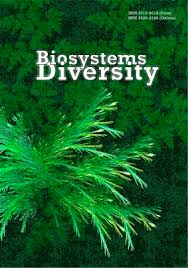Fouling communities of microscopic fungi on various substrates of the Black Sea
Fouling communities of microscopic fungi on various substrates of the Black Sea
Author(s): E. A. Bocharova, N. I. KopytinaSubject(s): Energy and Environmental Studies, Regional Geography, Transformation Period (1990 - 2010), Present Times (2010 - today)
Published by: Дніпропетровський національний університет імені Олеся Гончара
Keywords: marine fungi; concrete; mollusks; stones; wood; the Black Sea;
Summary/Abstract: Fungi are the most active biodeteriorators of natural and man-made materials. The article presents generalizations of the studies (2001–2019) of communities of microscopic fungi within biofilms on various substrates: shells of live Mytilus (Mytilus galloprovincialis, 670 specimens) and Ostreidae (Crassostrea gigas, 90 specimens), fragments of driftwood (over 7,000), stones (40), concrete of hydrotechnical constructions along the shoreline (80) and wood between concrete blocks in constructions on the shores (80). The studies were carried out in Odessa Oblast, the coastal zone of Sevastopol and open area of the Black Sea. There were identified 123 species of micromycetes, belonging to 65 genera, 33 families, 21 orders, 10 classes, 4 divisions, 2 kingdoms: Fungi and Chromista (fungi-like organisms). The Chromista kingdom was represented by 1 species – Ostracoblabe implexa, on shells of C. gigas. The number of species of micromycetes on various substrates varied 23 (wood between concrete blocks of hydrotechnical constructions) to 74 (shells of M. galloprovincialis at the depths of 3 and 6 m). On all the substrates, the following species were found; Alternaria alternata, Botryotrichum murorum. The communities were found to contain pathogenic fungi Aspergillus fumigatus (shells of mollusks, stones, concrete), A. terreus (concrete), Fusarium oxysporum, Pseudallescheria boydii (shells of mollusks). The best representation was seen for the Pleosporales order – from 12.9% (shells of M. galloprovincialis, 0.3 m depth) to 33.3% (shells of C. gigas) of the species composition. Toxin-producing species of Microascales in mycological communities accounted for 1.6% (driftwood) to 40.0% (concrete), and were also observed on shells of Bivalvia – 11.1–32.3%. Similarity of species composition of mycological communities according to Bray-Curtis coefficient varied 21.1% (driftwood and concrete, 10 shared species) to 72.7% (shells of M. galloprovincialis, the depths of 3 and 7 m and shells of C. gigas, 45 shared species). Using graphs of indices of mean taxonomic distinctness (AvTD, Δ+) and variation (Variation in Taxonomic Distinctness index, VarTD, Λ+), we determined deviations of taxonomic structure of the studied mycological communities from the level of mean expected values, calculated based on the list of species, taking into account their systematic positions. The lowest values of index Δ+ were determined for communities on shells of M. galloprovincialis, 0.3 m depth, driftwood, stones and concrete. These communities had uneven distribution of species according to higher taxonomic ranks and minimum number of the highest taxa: 4–6 classes, 1–2 divisions, Fungi kingdom. Disproportion in species composition with decrease in the number of the highest taxa occurred in extreme environmental conditions. Using index Λ+, we found that the most complex taxonomic structure of fungi communities has developed on concrete and shells of C. gigas. In mycological communities on those substrates, the number of species was low (25 and 46), but they belonged to 4–7 classes, 2–3 divisions, 1–2 kingdoms. To compare the structures of mycological communities that have developed in such substrates in biotopes sea, sea-land-air, land-air, we compiled a list of fungi based on the literature data, which, taking into account our data, comprised 445 species of 240 genera, 103 families, 51 orders, 15 classes, 5 divisions, 2 kingdoms. The analysis revealed that on substrates with similar chemical composition, in all the biotopes, the species of the same divisions dominated (genus and family may vary). Therefore, in the biotope land-air – Hypocreales, Pleosporales, Eurotiales (genera Acremonium, Fusarium, Alternaria, Aspergillus, Penicillium); sea – Pleosporales, Eurotiales, Microascales (Alternaria, Aspergillus, Penicillium, Corollospora); sea-land-air – Pleosporales, Microascales (Alternaria, Leptosphaeria, Aspergillus, Penicillium, Corollospora, Halosarpheia). Monitoring of species composition of myxomycetes is needed in farms that cultivate industrial objects, recreation sites, various buildings for prevention of mycotoxin intoxication and infestation by mycodermatoses and other diseases caused by opportunistic and pathogenic fungi.
Journal: Biosystems Diversity
- Issue Year: 29/2021
- Issue No: 4
- Page Range: 345-353
- Page Count: 9
- Language: English

